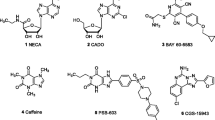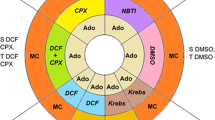Summary
The properties of 8-cyclopentyl-1,3-dipropylxanthine (DPCPX) as an antagonist ligand for A1 adenosine receptors were examined and compared with other radioligands for this receptor. DPCPX competitively antagonized both the inhibition of adenylate cyclase activity via A1 adenosine receptors and the stimulation via A2 adenosine receptors. The K 1-values of this antagonism were 0.45 nM at the A1 receptor of rat fat cells, and 330 nM at the A2 receptor of human platelets, giving a more than 700-fold A1-selectivity. A similar Al-selectivity was determined in radioligand binding studies. Even at high concentrations, DPCPX did not significantly inhibit the soluble cAMP-phosphodiesterase activity of human platelets. [3H]DPCPX (105 Ci/mmol) bound in a saturable manner with high affinity to A1 receptors in membranes of bovine brain and heart, and rat brain and fat cells (K D-values 50–190 pM). Its nonspecific binding was about 1 % of total at KD, except in bovine myocardial membranes (about 10%). Binding studies with bovine myocardial membranes allowed the analysis of both the high and low agonist affinity states of this receptor in a tissue with low receptor density. The binding properties of [3H]DPCPX appear superior to those of other agonist and antagonist radioligands for the A1 receptor.
Similar content being viewed by others
Abbreviations
- CHA:
-
N6-cyclohexyladenosine
- DPX:
-
1,3-diethyl-8-phenylxanthine
- HPIA:
-
N6-p-hydroxyphenylisopropyladenosine
- NECA,:
-
′-N-ethylcarboxamidoadenosine
- PIA:
-
N6-phenylisopro-pyladenosine
- XAC (“xanthine amine congener”):
-
8-{4-[([{(2aminoethyl)amino}carbonyl]methyl)oxy]phenyl-1,3-dipropyl-xanthine. 8-Cyclopentyl-1,3-dipropylxanthine is abbreviated DPCPX (from 1,3-dipropyl-8-cyclopentylxanthine)
References
Bauer AC, Schwabe U (1980) An improved assay of cyclic 3′,5′-nucleotide phosphodiesterases with QAE-Sephadex columns. Naunyn-Schmiedeberg's Arch Pharmacol 311:193–198
Berne RM, Rall TW, Rubio R (1983) Regulatory function of adenosine. Martinus Nijhoff, Den Haag
Böhm M, Brückner R, Neumann J, Schmitz W, Scholz H, Starbatty J (1986) Role of guanine nucleotide-binding protein in the regulation by adenosine of cardiac potassium conductance and force of contraction. Evaluation with pertussis toxin. Naunyn-Schmiedeberg's Arch Pharmacol 332:403–405
Bruns RF, Daly JW, Snyder SH (1980) Adenosine receptors in brain membranes: Binding of N6-cyclohexyl[3H]adenosine and 1,3-diethyl-8-[3H]phenylxanthine. Proc Natl Acad Sci USA 77:5547–5551
Bruns RF, Daly JW, Snyder SH (1983) Adenosine receptor binding: Structure-activity analysis generates extremely potent xanthine antagonists. Proc Natl Acad Sci USA 80:2077–2080
Bruns RF, Lu GH, Pugsley TA (1986) Characterization of the A2 adenosine receptor labeled by [3H]NECA in rat striatal membranes. Mol Pharmacol 29:331–346
Bruns RF, Fergus JH, Badger EW, Bristol JA, Santay LA, Hartman JD, Hays SJ, Huang CC (1987) Binding of the A1-selective antagonist 8-cyclopentyl-1,3-dipropylxanthine to rat brain membranes. Naunyn-Schmiedeberg's Arch Pharmacol 335: 59–63
De Lean A, Hancock AA, Lefkowitz RJ (1982) Validation and statistical analysis of a computer modeling method for quantitative analysis of radioligand binding data for mixtures of pharmacological receptor subtypes. Mol Pharmacol 21: 5–16
Dunwiddie TV (1985) The physiological role of adenosine in the central nervous system. Int Rev Neurobiol 27:63–139
Glowinski J, Iversen LL (1966) Regional studies of catecholamines in the rat brain. J Neurochem 13:655–669
Hoffman BB, Michel T, Brenneman TB, Lefkowitz RJ (1982) Interactions of agonists with platelet α2-adrenergic receptors. Endocrinology 110:926–932
Honnor RC, Dhillon GS, Londos C (1985) cAMP-dependent protein kinase and lipolysis in rat adipocytes. I. Cell preparation, manipulation, and predictability in behaviour. J Biol Chem 260:15122–15129
Jacobson KA, Ukena D, Kirk KL, Daly JW (1986) [3H]Xanthine amine congener of 1,3-dipropyl-8-phenylxanthine: An antagonist radioligand for adenosine receptors. Proc Natl Acad Sci USA 83:4089–4093
Klotz K-N, Cristalli G, Grifantini M, Vittori S, Lohse MJ (1985) Photoaffinity labeling of A1 adenosine receptors. J Biol Chem 260:14659–14664
Lee KS, Reddington M (1986) 1,3-Dipropyl-8-cyclopentylxanthine (DPCPX) inhibition of [3H]N-ethylcarboxamidoadenosine (NECA) binding allows the visualization of putative non-A1 adenosine receptors. Brain Res 368:394–398
Linden J, Patel A, Sadek S (1985) [125I]Aminobenzyladenosine, a new radioligand with improved specific binding to adenosine receptors in heart. Circ Res 56:279–284
Lohse MJ, Lenschow V, Schwabe U (1984a) Two affinity states of R1 adenosine receptors in brain membranes: Analysis of guanine nucleotide and temperature effects on radioligand binding. Mol Pharmacol 26:1–9
Lohse MJ, Lenschow V, Schwabe U (1984b) Interaction of barbiturates with adenosine receptors in rat brain. Naunyn-Schmiedeberg's Arch Pharmacol 326:69–74
Lohse MJ, Ukena D, Schwabe U (1985) Demonstration of R1-type adenosine receptors in bovine myocardium by radioligand binding. Naunyn-Schmiedeberg's Arch Pharmacol 328:310–316
Lohse MJ, Klotz K-N, Schwabe U (1986) Agonist photoaffinity labelling of A1 adenosine receptors: Persistent activation reveals spare receptors. Mol Pharmacol 30:403–409
Londos C, Cooper DMF, Wolff J (1980) Subclasses of external adenosine receptors. Proc Natl Acad Sci USA 77:2551–2554
McKeel DW, Jarett L (1970) Preparation and characterization of a plasma membrane fraction from isolated fat cells. J Cell Biol 44:417–432
Papesch V, Schroeder EF (1951) Synthesis of 1-mono and 1,3-disubstituted 6-aminouracils. Diuretic activity. J Org Chem 16:1879–1890
Peterson GL (1977) A simplification of the protein assay method of Lowry et al. which is more generally applicable. Anal Biochem 83:346–356
Schwabe U, Trost T (1980) Characterization of adenosine receptors in rat brain by (−)[3H]N6-phenylisopropyladenosine. Naunyn-Schmiedeberg's Arch Pharmacol 313:179–187
Schwabe U, Lenschow V, Ukena D, Ferry DR, Glossmann H (1982) [125I]N6-p-Hydroxyphenylisopropyladenosine, a new ligand for R1 adenosine receptors. Naunyn-Schmiedeberg's Arch Pharmacol 321:84–87
Schwabe U, Ukena D, Lohse MJ (1985) Xanthine derivatives as antagonists at A1 and A2 adenosine receptors. Naunyn-Schmiedeberg's Arch Pharmacol 330:212–221
Smellie FW, Davis CW, Daly JW, Wells JN (1979) Alkylxanthines: Inhibition of adenosine-elicited accumulation of cyclic AMP in brain slices and of brain phosphodiesterase activity. Life Sci 24:2475–2482
Van Calker D, Müller M, Hamprecht B (1978) Adenosine inhibits the accumulation of cyclic AMP in cultured brain cells. Nature (Lond) 276:839–841
Walseth TF, Johnson RA (1979) The enzymatic preparation of [α-32P]nucleoside triphosphates, cyclic [32P]AMP and cyclic [32p]GMP. Biochim Biophys Acta 526:11–31
Weishaar RE, Cain MH, Bristol JA (1985) A new generation of phosphodiesterase inhibitiors: multiple molecular forms of phosphodiesterase and the potential for drug selectivity. J Med Chem 28:537–545
Williams M, Braunwalder A, Erickson TJ (1986) Evaluation of the binding of the A-1 selective adenosine radioligand cyclopentyladenosine (CPA), to rat brain tissue. Naunyn-Schmiedeberg's Arch Pharmacol 332:179–183
Author information
Authors and Affiliations
Additional information
Send offprint requests to M. J. Lohse at the above address
Rights and permissions
About this article
Cite this article
Lohse, M.J., Klotz, KN., Lindenborn-Fotinos, J. et al. 8-Cyclopentyl-1,3-dipropylxanthine (DPCPX) — a selective high affinity antagonist radioligand for A1 adenosine receptors. Naunyn-Schmiedeberg's Arch Pharmacol 336, 204–210 (1987). https://doi.org/10.1007/BF00165806
Received:
Accepted:
Issue Date:
DOI: https://doi.org/10.1007/BF00165806




